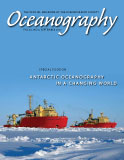Article Abstract
Scientific and political interests at the poles are significant and rapidly increasing, driven in part by the effects of climate change and emerging geopolitical realities. The polar regions provide important services to global ecosystems and humankind, ranging from food and energy to freshwater and biodiversity. Yet the poles are experiencing changes at rates that far outpace the rest of the planet. Coastal Arctic communities are impacted by climate change through coastal erosion, sea level rise, ice loss, and altered marine food webs, threatening the future of their subsistence lifestyle. Climate change has dramatically increased the melt rate of ice sheets and glaciers at both poles and has the potential to significantly raise sea level worldwide. Oil and gas drilling as well as transportation in the Arctic have reached all-time high levels, in part because of reduced sea ice cover. Tourism is a growing industry at both poles, bringing more than 20,000 tourists each year to the western Antarctic Peninsula alone. The collateral effects of human activities include the potential for pollution of the marine environment, particularly through spills of hydrocarbons. Our ability to understand the effects of such activities and mishaps is limited, particularly in ice-covered areas during winter.

